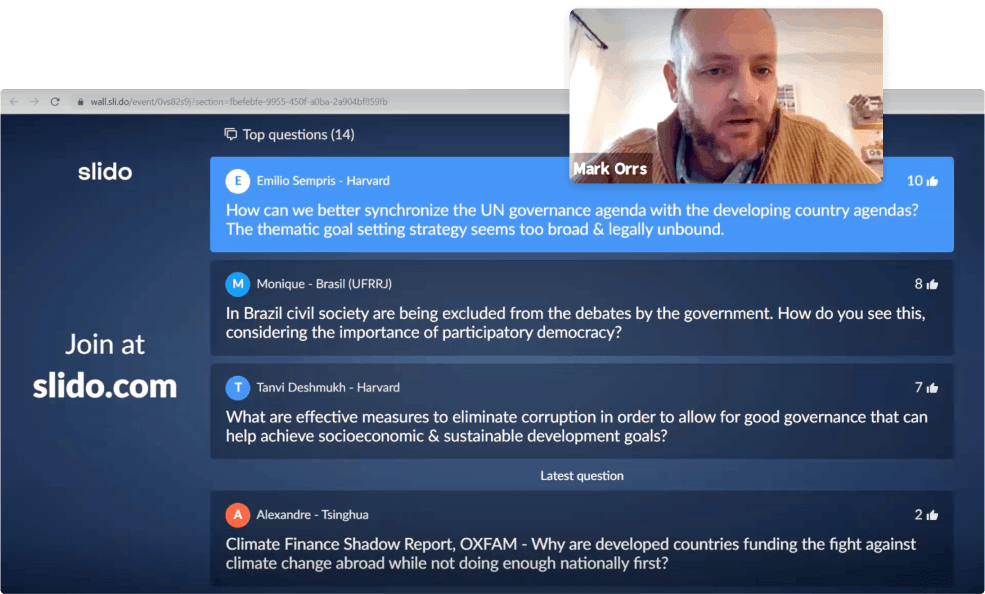Thanks to Slido, our Q&As are now much more inclusive, substantive, and easier to manage during virtual classes.

Thanks to Slido, our Q&As are now much more inclusive, substantive, and easier to manage during virtual classes.

Back in 2008, the International Commission on Education for Sustainable Development Practice launched an experimental training course for development professionals. The Global Classroom was born.
One year later, this first-of-its-kind, fully-remote graduate course was officially adopted by the Masters of Development Practice (MDP) programs at various high-profile academic institutions.
Since then, the course has reached thousands of students at more than 35 universities, in 26 countries around the world. Each week, 500 students join a virtual class on Zoom.
Most students join as a class, but some do it individually due to time zones,
says the course facilitator, Mark Orrs, Consultant to the Earth Institute at Columbia University.
The course lecturers include Nobel Prize laureates and high-profile government ministers.
But facilitating a discussion online has its own challenges.
We didn’t have an easy way to collect questions. Using the chat on Zoom for that was clunky, and not the most democratic. The incoming stream of questions was difficult to manage.
Two years ago, Audrey Tang, Taiwan’s Digital Minister, introduced them to Slido during her guest lecture. We were sold on it immediately,
recalls Mark, smiling.
Here is Mark’s story about how they made virtual classes more effective with Slido.
Before Slido, there were several obstacles that the course leaders had to overcome in order to create an equitable classroom.
First, some schools with fewer resources struggled with poor connectivity. When students asked questions verbally, it was choppy and hard to understand,
recalls Mark.
To improve the stream’s quality, they moved to a low-bandwidth solution, Zoom, and started using Zoom chat to collect questions.
But then came the second challenge: the process was still a bit cumbersome.
When I facilitated the Q&A, I was lost in the stream of questions, and it was difficult to navigate through them. We also had many duplicates.
This process wasn’t easy for students either. To ask a question, they had to get their teacher’s attention and ask him or her to type that question into the chat.
Mark read these questions out in the order they came in during the Q&A, which created the third challenge: he had no way of identifying the most relevant questions.
When Audrey Tang introduced them to Slido, she turned the traditional lecture upside down.
Audrey let the students drive the conversation. She covered her main points in 10 minutes, and for the rest of the class, she focused solely on students' questions in Slido.
Seeing Slido in practice convinced Mark to incorporate the tool into all their virtual classes.
A week before each class, Mark sends out an email to all schools with the class materials, including a link to Slido.
This way, students can post questions while doing class readings. It usually brings us around ten well-considered questions at the start of each class,
says Mark.
This is how each 75-minute virtual class looks.
When they start the broadcast, Mark introduces the speaker and invites students to send their questions to Slido. Then, the speaker presents for 40 minutes, screen-sharing the slides.
After the lecture, Mark spends the remaining 35 minutes facilitating a live discussion between the students and the speaker. He shares his screen and displays the questions in Slido.

To help Mark identify the most relevant questions, he lets students upvote the ones they like.
It helps me to curate the best questions and add interactivity. The most voted questions make it to the top, and I address those first. I can also tag and group questions by topic,
Mark adds.
To make it more personal and ensure geographic diversity, Mark asks students to identify where they're from. Students can also post questions anonymously if they prefer.
The technical setup of the classes is handled by two staff members at one of the partnering universities.
They help me to ensure that the technology works smoothly. One of them deals with the speakers and instructs them about the setup before the lecture. The second one helps to troubleshoot any issues during the class.
Implementing Slido made Mark’s job of facilitating the virtual Q&A much easier. As a result, their remote classes are more democratic and everyone has an equal chance to participate.
Letting the students vote on their favorite questions helps us to weed out the irrelevant ones in a friendly, discreet way.
We used to get complaints about the representativeness of questions, but this has all gone thanks to Slido.
Slido is intuitive, seamless, and easy to use for both students and facilitators.